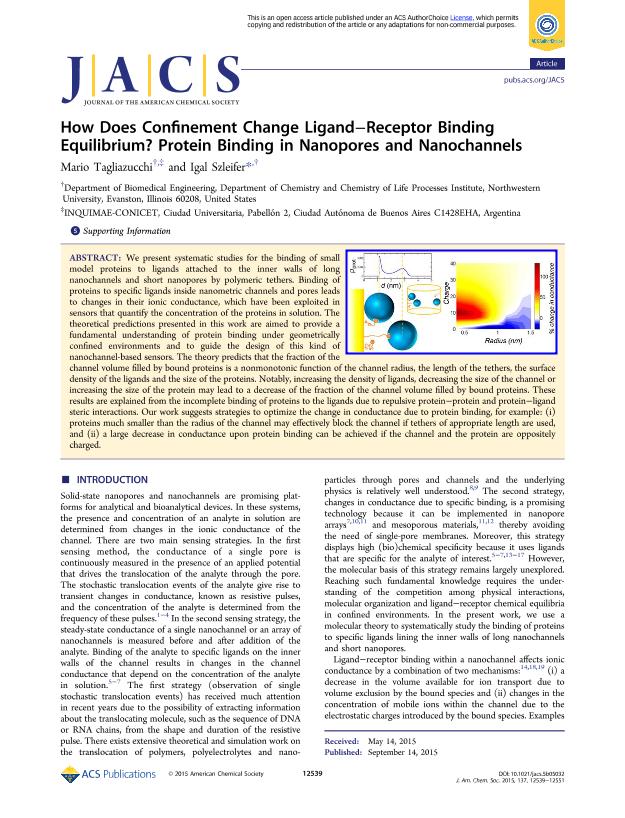Mostrar el registro sencillo del ítem
dc.contributor.author
Tagliazucchi, Mario Eugenio

dc.contributor.author
Szleifer, Igal

dc.date.available
2019-07-27T19:32:59Z
dc.date.issued
2015-10
dc.identifier.citation
Tagliazucchi, Mario Eugenio; Szleifer, Igal; How does confinement change ligand-receptor binding equilibrium? Protein binding in nanopores and nanochannels; American Chemical Society; Journal of the American Chemical Society; 137; 39; 10-2015; 12539-12551
dc.identifier.issn
0002-7863
dc.identifier.uri
http://hdl.handle.net/11336/80444
dc.description.abstract
We present systematic studies for the binding of small model proteins to ligands attached to the inner walls of long nanochannels and short nanopores by polymeric tethers. Binding of proteins to specific ligands inside nanometric channels and pores leads to changes in their ionic conductance, which have been exploited in sensors that quantify the concentration of the proteins in solution. The theoretical predictions presented in this work are aimed to provide a fundamental understanding of protein binding under geometrically confined environments and to guide the design of this kind of nanochannel-based sensors. The theory predicts that the fraction of the channel volume filled by bound proteins is a nonmonotonic function of the channel radius, the length of the tethers, the surface density of the ligands and the size of the proteins. Notably, increasing the density of ligands, decreasing the size of the channel or increasing the size of the protein may lead to a decrease of the fraction of the channel volume filled by bound proteins. These results are explained from the incomplete binding of proteins to the ligands due to repulsive protein-protein and protein-ligand steric interactions. Our work suggests strategies to optimize the change in conductance due to protein binding, for example: (i) proteins much smaller than the radius of the channel may effectively block the channel if tethers of appropriate length are used, and (ii) a large decrease in conductance upon protein binding can be achieved if the channel and the protein are oppositely charged.
dc.format
application/pdf
dc.language.iso
eng
dc.publisher
American Chemical Society

dc.rights
info:eu-repo/semantics/openAccess
dc.rights.uri
https://creativecommons.org/licenses/by-nc-sa/2.5/ar/
dc.subject
Theory
dc.subject
Protein Binding
dc.subject
Nanochannel
dc.subject
...
dc.subject.classification
Físico-Química, Ciencia de los Polímeros, Electroquímica

dc.subject.classification
Ciencias Químicas

dc.subject.classification
CIENCIAS NATURALES Y EXACTAS

dc.title
How does confinement change ligand-receptor binding equilibrium? Protein binding in nanopores and nanochannels
dc.type
info:eu-repo/semantics/article
dc.type
info:ar-repo/semantics/artículo
dc.type
info:eu-repo/semantics/publishedVersion
dc.date.updated
2019-06-11T19:46:42Z
dc.journal.volume
137
dc.journal.number
39
dc.journal.pagination
12539-12551
dc.journal.pais
Estados Unidos

dc.description.fil
Fil: Tagliazucchi, Mario Eugenio. Consejo Nacional de Investigaciones Científicas y Técnicas. Oficina de Coordinación Administrativa Ciudad Universitaria. Instituto de Química, Física de los Materiales, Medioambiente y Energía. Universidad de Buenos Aires. Facultad de Ciencias Exactas y Naturales. Instituto de Química, Física de los Materiales, Medioambiente y Energía; Argentina. Northwestern University; Estados Unidos
dc.description.fil
Fil: Szleifer, Igal. Northwestern University; Estados Unidos
dc.journal.title
Journal of the American Chemical Society

dc.relation.alternativeid
info:eu-repo/semantics/altIdentifier/url/http://pubs.acs.org/doi/abs/10.1021/jacs.5b05032
dc.relation.alternativeid
info:eu-repo/semantics/altIdentifier/doi/http://dx.doi.org/10.1021/jacs.5b05032
Archivos asociados
